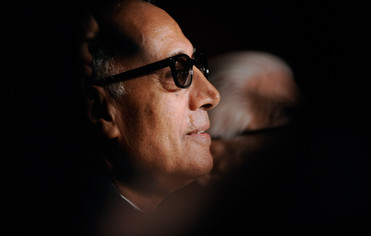Abbas Kiarostami
Abbas Kiarostami (Persian: عباس کیارستمی Abbās Kiyārostamī; born 22 June 1940) is an internationally acclaimed Iranian film director, screenwriter, photographer and film producerAn active filmmaker since 1970, Kiarostami has been involved in over forty films, including shorts and documentaries. Kiarostami attained critical acclaim for directing the Koker Trilogy (1987–94), Taste of Cherry (1997), and The Wind Will Carry Us (1999). In his recent films, Certified Copy (2010) and Like Someone in Love (2012), he filmed for the first time outside Iran, in France and Japan, respectively.
Kiarostami has worked extensively as a screenwriter, film editor, art director and producer and has designed credit titles and publicity material. He is also a poet, photographer, painter, illustrator, and graphic designer. He is part of a generation of filmmakers in the Iranian New Wave, a Persian cinema movement that started in the late 1960s and includes pioneering directors such as Forough Farrokhzad, Sohrab Shahid Saless, Mohsen Makhmalbaf, Bahram Beizai, and Parviz Kimiavi. These filmmakers share many common techniques including the use of poetic dialogue and allegorical storytelling dealing with political and philosophical issues.
Kiarostami has a reputation for using child protagonists, for documentary-style narrative films, for stories that take place in rural villages, and for conversations that unfold inside cars, using stationary mounted cameras. He is also known for his use of contemporary Iranian poetry in the dialogue, titles, and themes of his films.
Early life and background
Kiarostami majored in painting and graphic design at the University of Tehran College of Fine Arts.
Kiarostami was born in Tehran. His first artistic experience was painting, which he continued into his late teens, winning a painting competition at the age of 18 shortly before he left home to study at the University of Tehran School of Fine Arts. He majored in painting and graphic design, and supported his studies by working as a traffic policeman.
As a painter, designer, and illustrator, Kiarostami worked in advertising in the 1960s, designing posters and creating commercials. Between 1962 and 1966, he shot around 150 advertisements for Iranian television. In the late 1960s, he began creating credit titles for films (including Gheysar by Masoud Kimiai) and illustrating children's books.
Marriage and family
In 1969, Abbas married Parvin Amir-Gholi. They had two sons, Ahmad (born 1971) and Bahman (1978). They divorced in 1982. At the age of 15, Bahman Kiarostami worked as a director and cinematographer in making the documentary Journey to the Land of the Traveller (1993).
Film career
Kiarostami was one of the few directors who remained in Iran after the 1979 revolution, when many of his peers fled the country. He believes that it was one of the most important decisions of his career. His permanent base in Iran and his national identity have consolidated his ability as a filmmaker:
"When you take a tree that is rooted in the ground, and transfer it from one place to another, the tree will no longer bear fruit. And if it does, the fruit will not be as good as it was in its original place. This is a rule of nature. I think if I had left my country, I would be the same as the tree." -Abbas Kiarostami Kiarostami frequently wears dark spectacles or sunglasses. He needs them as he has a sensitivity to light.
In 2000, at the San Francisco Film Festival award ceremony, Kiarostami surprised everyone by giving away his Akira Kurosawa Prize for lifetime achievement in directing to veteran Iranian actor Behrooz Vossoughi for his contribution to Iranian cinema.
Film career
1970s
In 1969, when the Iranian New Wave began with Dariush Mehrjui's film Gāv, Kiarostami helped set up a filmmaking department at the Institute for Intellectual Development of Children and Young Adults (Kanun) in Tehran. Its debut production and Kiarostami's first film was the twelve-minute The Bread and Alley (1970), a neo-realistic short film about a schoolboy's confrontation with an aggressive dog. Breaktime followed in 1972. The department became one of Iran's most noted film studios, producing not only Kiarostami's films, but acclaimed Persian films such as The Runner and Bashu, the Little Stranger.
A close-up of the boy in Kiarostami's first film The Bread and Alley (1970)
In the 1970s, Kiarostami pursued an individualistic style of film making. When discussing his first film, he stated:
"Bread and Alley was my first experience in cinema and I must say a very difficult one. I had to work with a very young child, a dog, and an unprofessional crew except for the cinematographer, who was nagging and complaining all the time. Well, the cinematographer, in a sense, was right because I did not follow the conventions of film making that he had become accustomed to."
Following The Experience (1973), Kiarostami released The Traveller (Mossafer) in 1974. The Traveller tells the story of Hassan Darabi, a troublesome, amoral ten-year-old boy in a small Iranian town. He wishes to see the Iran national football team play an important match in Tehran. In order to achieve that, he scams his friends and neighbors. After a number of adventures, he finally reaches Tehran stadium in time for the match. The film addresses the boy's determination in his goal, and his indifference to the effects of his actions on other people, particularly those closest to him. The film is an examination of human behavior and the balance of right and wrong. The film furthered Kiarostami's reputation of realism, diegetic simplicity, and stylistic complexity, as well as his fascination with physical and spiritual journeys.
In 1975, Kiarostami directed two short films So Can I and Two Solutions for One Problem. In early 1976, he released Colors, followed by the fifty-four minute film A Wedding Suit, a story about three teenagers coming into conflict over a suit for a wedding.
Kiarostami's first feature film was the 112-minute Report (1977). It revolved around the life of a tax collector accused of accepting bribes; suicide was among its themes. In 1979, he produced and directed First Case, Second Case.
1980s
In the early 1980s, Kiarostami directed several short films including Dental Hygiene (1980), Orderly or Disorderly (1981), and The Chorus (1982). In 1983, he directed Fellow Citizen. It was not until his release of Where Is the Friend's Home? that he began to gain recognition outside Iran.
The film tells a simple account of a conscientious eight-year-old schoolboy's quest to return his friend's notebook in a neighboring village lest his friend be expelled from school. The traditional beliefs of Iranian rural people are portrayed. The film has been noted for its poetic use of the Iranian rural landscape and its realism, both important elements of Kiarostami's work. Kiarostami made the film from a child's point of view.
Where Is the Friend's Home?, And Life Goes On (1992) (also known as Life and Nothing More), and Through the Olive Trees (1994) are described by critics as the Koker trilogy, because all three films feature the village of Koker in northern Iran. The films also relate to the 1990 Manjil-Rudbar earthquake, in which 40,000 people lost their lives. Kiarostami uses the themes of life, death, change, and continuity to connect the films. The trilogy was successful in France in the 1990s and other Western European countries such as the Netherlands, Sweden, Germany and Finland.[19] But, Kiarostami does not consider the three films to comprise a trilogy. He has suggested that the last two titles plus Taste of Cherry (1997) comprise a trilogy, given their common theme of the preciousness of life. In 1987, Kiarostami was involved in the screenwriting of The Key, which he edited but did not direct. In 1989, he released Homework.
1990s
Kiarostami's first film of the decade was Close-Up (1990), which narrates the story of the real-life trial of a man who impersonated film-maker Mohsen Makhmalbaf, conning a family into believing they would star in his new film. The family suspects theft as the motive for this charade, but the impersonator, Hossein Sabzian, argues that his motives were more complex. The part-documentary, part-staged film examines Sabzian's moral justification for usurping Makhmalbaf's identity, questioning his ability to sense his cultural and artistic flair.Close-Up received praise from directors such as Quentin Tarantino, Martin Scorsese, Werner Herzog, Jean-Luc Godard, and Nanni Moretti[23] and was released across Europe.
In 1992, Kiarostami directed Life, and Nothing More..., regarded by critics as the second film of the Koker trilogy. The film follows a father and his young son as they drive from Tehran to Koker in search of two young boys who they fear might have perished in the 1990 earthquake. As the father and son travel through the devastated landscape, they meet earthquake survivors forced to carry on with their lives amid disaster.That year Kiarostami won a Prix Roberto Rossellini, the first professional film award of his career, for his direction of the film. The last film of the so-called Koker trilogy was Through the Olive Trees (1994), which expands a peripheral scene from Life and Nothing More into the central drama. Critics such as Adrian Martin have called the style of filmmaking in the Koker trilogy as "diagrammatical", linking the zig-zagging patterns in the landscape and the geometry of forces of life and the world. A flashback of the zigzag path in Life and Nothing More... (1992) in turn triggers the spectator's memory of the previous film, Where Is the Friend's Home? from 1987, shot before the earthquake. This symbolically links to the post-earthquake reconstruction in Through the Olive Trees in 1994. In 1995, Miramax Films released Through the Olive Trees in the US theaters.
Kiarostami next wrote the screenplays for The Journey and The White Balloon (1995), for his former assistant Jafar Panahi.[6] Between 1995 and 1996, he was involved in the production of Lumière and Company, a collaboration with 40 other film directors.
Kiarostami won the Palme d'Or (Golden Palm) award at the Cannes Film Festival for Taste of Cherry. It is the drama of a man, Mr. Badii, determined to commit suicide. The film involved themes such as morality, the legitimacy of the act of suicide, and the meaning of compassion.
Kiarostami directed The Wind Will Carry Us in 1999, which won the Grand Jury Prize (Silver Lion) at the Venice International Film Festival. The film contrasted rural and urban views on the dignity of labor, addressing themes of gender equality and the benefits of progress, by means of a stranger's sojourn in a remote Kurdish village. An unusual feature of the movie is that many of the characters are heard but not seen; at least thirteen to fourteen speaking characters in the film are never seen.
2000s
In 2001, Kiarostami and his assistant, Seifollah Samadian, traveled to Kampala, Uganda at the request of the United Nations International Fund for Agricultural Development, to film a documentary about programs assisting Ugandan orphans. He stayed for ten days and made ABC Africa. The trip was originally intended as a research in preparation for the filming, but Kiarostami ended up editing the entire film from the video footage shot there. The high number of orphans in Uganda has resulted from the deaths of parents in the AIDS epidemic.
Time Out editor and National Film Theatre chief programmer, Geoff Andrew, said in referring to the film: "Like his previous four features, this film is not about death but life-and-death: how they're linked, and what attitude we might adopt with regard to their symbiotic inevitability."
The following year, Kiarostami directed Ten, revealing an unusual method of filmmaking and abandoning many scriptwriting conventions.Kiarostami focused on the socio-political landscape of Iran. The images are seen through the eyes of one woman as she drives through the streets of Tehran over a period of several days. Her journey is composed of ten conversations with various passengers, which include her sister, a hitchhiking prostitute, and a jilted bride and her demanding young son. This style of filmmaking was praised by a number of critics.
A. O. Scott in The New York Times wrote that Kiarostami, "in addition to being perhaps the most internationally admired Iranian filmmaker of the past decade, is also among the world masters of automotive cinema...He understands the automobile as a place of reflection, observation and, above all, talk."
In 2003, Kiarostami directed Five, a poetic feature with no dialogue or characterization. It consists of five long shots of nature which are single-take sequences, shot with a hand-held DV camera, along the shores of the Caspian Sea. Although the film lacks a clear storyline, Geoff Andrew argues that the film is "more than just pretty pictures". He adds, "Assembled in order, they comprise a kind of abstract or emotional narrative arc, which moves evocatively from separation and solitude to community, from motion to rest, near-silence to sound and song, light to darkness and back to light again, ending on a note of rebirth and regeneration." He notes the degree of artifice concealed behind the apparent simplicity of the imagery.
Kiarostami produced 10 on Ten (2004), a journal documentary that shares ten lessons on movie-making while he drives through the locations of his past films. The movie is shot on digital video with a stationary camera mounted inside the car, in a manner reminiscent of Taste of Cherry and Ten. In 2005 and 2006, he directed The Roads of Kiarostami, a 32-minute documentary that reflects on the power of landscape, combining austere black-and-white photographs with poetic observations,engaging music with political subject matter. Also in 2005, Kiarostami contributed the central section to Tickets, a portmanteau film set on a train traveling through Italy. The other segments were directed by Ken Loach and Ermanno Olmi.
In 2008, Kiarostami directed the feature Shirin, which features close-ups of many notable Iranian actresses and the French actress Juliette Binoche as they watch a film based on a partly mythological Persian romance tale of Khosrow and Shirin, with themes of female self-sacrifice.[39][40] The film has been described as "a compelling exploration of the relationship between image, sound and female spectatorship."
2010s
Certified Copy (2010), again starring Juliette Binoche, was made in Tuscany. It is Kiarostami's first film to be shot and produced outside Iran. The story of an encounter between a British man and a French woman, it was entered in competition for the Palme d'Or in the 2010 Cannes Film Festival. Peter Bradshaw of The Guardian describes the film as an "intriguing oddity", and said, "'Certified Copy' is the deconstructed portrait of a marriage, acted with well-intentioned fervour by Juliette Binoche, but persistently baffling, contrived, and often simply bizarre – a highbrow misfire of the most peculiar sort."He concluded that the film is "unmistakably an example of Kiarostami's compositional technique, though not a successful example." Roger Ebert, however, praised the film, noting that "Kiarostami is rather brilliant in the way he creates offscreen spaces." Binoche won the Best Actress Award at Cannes for her performance in the film. Kiarostami's next, Like Someone in Love, set and shot in Japan, received mixed reviews and even some pans upon its premiere at the 2012 Cannes Film Festival.
Film festival work
Kiarostami (left) at the Estoril Film Festival in 2010
Kiarostami has been a jury member at numerous film festivals, most notably the Cannes Film Festival in 1993, 2002 and 2005. He was also the president of the Caméra d'Or Jury in Cannes Film Festival 2005. Other representatives include the Venice Film Festival in 1985, the Locarno International Film Festival in 1990, the San Sebastian International Film Festival in 1996, the São Paulo International Film Festival in 2004, the Capalbio Cinema Festival in 2007 (in which he was president of the jury), and the Küstendorf Film and Music Festival in 2011.He also makes regular appearances at many other film festivals across Europe, including the Estoril Film Festival in Portugal.
Cinematic style
Main article: Cinematic style of Abbas Kiarostami
Individualism
Though Kiarostami has been compared to Satyajit Ray, Vittorio de Sica, Éric Rohmer, and Jacques Tati, his films exhibit a singular style, often employing techniques of his own invention.
During the filming of The Bread and Alley in 1970, Kiarostami had major differences with his experienced cinematographer about how to film the boy and the attacking dog. While the cinematographer wanted separate shots of the boy approaching, a close up of his hand as he enters the house and closes the door, followed by a shot of the dog, Kiarostami believed that if the three scenes could be captured as a whole it would have a more profound impact in creating tension over the situation. That one shot took around forty days to complete, until Kiarostami was fully content with the scene. Kiarostami later commented that the breaking of scenes would have disrupted the rhythm and content of the film's structure, preferring to let the scene flow as one.
Unlike other directors, Kiarostami has showed no interest in staging extravagant combat scenes or complicated chase scenes in large-scale productions, instead attempting to mold the medium of film to his own specifications.[46] Kiarostami appeared to have settled on his style with the Koker trilogy, which included a myriad of references to his own film material, connecting common themes and subject matter between each of the films. Stephen Bransford has contended that Kiarostami's films do not contain references to the work of other directors, but are fashioned in such a manner that they are self-referenced. Bransford believes his films are often fashioned into an ongoing dialectic with one film reflecting on and partially demystifying an earlier film.
He has continued experimenting with new modes of filming, using different directorial methods and techniques. A case in point is Ten, which was filmed in a moving automobile in which Kiarostami was not present. He gave suggestions to the actors about what to do, and a camera placed on the dashboard filmed them while they drove around Tehran. The camera was allowed to roll, capturing the faces of the people involved during their daily routine, using a series of extreme-close shots. Ten was an experiment that used digital cameras to virtually eliminate the director. This new direction towards a Digital-Micro-Cinema, is defined as a micro-budget filmmaking practice, allied with a digital production basis.
Kiarostami's cinema offers a different definition of film. According to film professors such as Jamsheed Akrami of William Paterson University, Kiarostami has consistently tried to redefine film by forcing the increased involvement of the audience. In recent years, he has also progressively trimmed the timespan within his films. Akrami thinks that this reduces the filmmaking from a collective endeavor to a purer, more basic form of artistic expression.
Fiction and non-fiction
Kiarostami's films contain a notable degree of ambiguity, an unusual mixture of simplicity and complexity, and often a mix of fictional and documentary elements. Kiarostami has stated, "We can never get close to the truth except through lying."
The boundary between fiction and non-fiction is significantly reduced in Kiarostami's cinema.[50] The French philosopher Jean-Luc Nancy, writing about Kiarostami, and in particular Life and Nothing More..., has argued that his films are neither quite fiction nor quite documentary. Life and Nothing More..., he argues, is neither representation nor reportage, but rather "evidence":
[I]t all looks like reporting, but everything underscores (indique à l'évidence) that it is the fiction of a documentary (in fact, Kiarostami shot the film several months after the earthquake), and that it is rather a document about "fiction": not in the sense of imagining the unreal, but in the very specific and precise sense of the technique, of the art of constructing images. For the image by means of which, each time, each opens a world and precedes himself in it (s'y précède) is not pregiven (donnée toute faite) (as are those of dreams, phantasms or bad films): it is to be invented, cut and edited. Thus it is evidence, insofar as, if one day I happen to look at my street on which I walk up and down ten times a day, I construct for an instant a new evidence of my street.
For Jean-Luc Nancy, this notion of cinema as "evidence", rather than as documentary or imagination, is tied to the way Kiarostami deals with life-and-death (cf. the remark by Geoff Andrew on ABC Africa, cited above, to the effect that Kiarostami's films are not about death but about life-and-death):
Existence resists the indifference of life-and-death, it lives beyond mechanical "life," it is always its own mourning, and its own joy. It becomes figure, image. It does not become alienated in images, but it is presented there: the images are the evidence of its existence, the objectivity of its assertion. This thought—which, for me, is the very thought of this film [Life and Nothing More...]—is a difficult thought, perhaps the most difficult. It's a slow thought, always under way, fraying a path so that the path itself becomes thought. It is that which frays images so that images become this thought, so that they become the evidence of this thought—and not in order to "represent" it.
In other words, wanting to accomplish more than just represent life and death as opposing forces, but rather to illustrate the way in which each element of nature is inextricably linked, Kiarostami has devised a cinema that does more than just present the viewer with the documentable "facts," but neither is it simply a matter of artifice. Because "existence" means more than simply life, it is projective, containing an irreducibly fictive element, but in this "being more than" life, it is therefore contaminated by mortality. Nancy is giving a clue, in other words, toward the interpretation of Kiarostami's statement that lying is the only way to truth.
Themes of life and death
The concepts of change and continuity, in addition to the themes of life and death, play a major role in Kiarostami's works. In the Koker trilogy, these themes play a central role. As illustrated in the aftermath of the 1990 Tehran earthquake disaster, they also represent the power of human resilience to overcome and defy destruction.
Unlike the Koker films, which convey an instinctual thirst for survival, Taste of Cherry explores the fragility of life and focuses on how precious it is.
Symbols of death abound in The Wind Will Carry Us, with the scenery of the graveyard, the imminence of the old woman's passing, and the ancestors referred to early in the film by the character Farzad. Such devices prompt the viewer to reflect on the parameters of the afterlife and immaterial existence. The viewer is asked to consider what constitutes the soul, and what happens to it after death. In discussing the film, Kiarostami has said that he is the person who raises questions, rather than answers them.
Some film critics believe that the assemblage of light versus dark scenes in Kiarostami's film grammar, such as in Taste of Cherry and Wind Will Carry Us, suggests the mutual existence of life with its endless possibilities, and death as a factual moment of anyone's life.
Visual and audio techniques
Kiarostami's style is notable for the use of panoramic long shots, such as in the closing sequences of Life and Nothing More and Through the Olive Trees, where the audience is intentionally distanced physically from the characters in order to stimulate reflection on their fate. Taste of Cherry is punctuated throughout by shots of this kind, including distant overhead shots of the suicidal Badii's car moving across the hills, usually while he is conversing with a passenger. However, the visual distancing techniques stand in juxtaposition to the sound of the dialog, which always remains in the foreground. Like the coexistence of a private and public space, or the frequent framing of landscapes through car windows, this fusion of distance with proximity can be seen as a way of generating suspense in the most mundane of moments.
This relationship between distance and intimacy, between imagery and sound, is also present in the opening sequence to The Wind Will Carry Us. Michael J. Anderson has argued that such a thematic application of this central concept of presence without presence, through using such techniques, and by often referring to characters which the viewer does not see and sometimes not hear directly affects the nature and concept of space in the geographical framework in which the world is portrayed. Kiarostami's use of sound and imagery conveys a world beyond what is directly visible and/or audible, which Anderson believes emphasizes the interconnectedness and shrinking of time and space in the modern world of telecommunications.
Other commentators such as film critic Ben Zipper believe that Kiarostami's work as a landscape artist is evident in his compositional distant shots of the dry hills throughout a number of his films directly impacting on his construction on the rural landscapes within his films.
Poetry and imagery
Ahmad Karimi-Hakkak, of the University of Maryland, argues that one aspect of Kiarostami's cinematic style is that he is able to capture the essence of Persian poetry and create poetic imagery within the landscape of his films. In several of his movies such as Where is the Friend's Home and The Wind Will Carry Us, classical Persian poetry is directly quoted in the film, highlighting the artistic link and intimate connection between them. This in turn reflects on the connection between the past and present, between continuity and change.
Tomb of Khayyam, Persian poet and philosopher in Nishapur
The characters recite poems mainly from classical Persian poet Omar Khayyám or modern Persian poets such as Sohrab Sepehri and Forough Farrokhzad. One scene in The Wind Will Carry Us has a long shot of a wheat field with rippling golden crops through which the doctor, accompanied by the filmmaker, is riding his scooter in a twisting road. In response to the comment that the other world is a better place than this one, the doctor recites this poem of Khayyam:
“ They promise of houries in heaven
But I would say wine is better
Take the present to the promises
A drum sounds melodious from distance
However, the aesthetic element involved with the poetry goes much farther back in time and is used more subtly than these examples suggest. Beyond issues of adaptation of text to film, Kiarostami often begins with an insistent will to give visual embodiment to certain specific image-making techniques in Persian poetry, both classical and modern. This prominently results in enunciating a larger philosophical position, namely the ontological oneness of poetry and film.
It has been argued that the creative merit of Kiarostami's adaptation of Sohrab Sepehri and Forough Farrokhzad's poems extends the domain of textual transformation. Adaptation is defined as the transformation of a prior to a new text. Sima Daad of the University of Washington contends that Kiarostami's adaptation arrives at the theoretical realm of adaptation by expanding its limit from inter-textual potential to trans-generic potential.
Spirituality
Kiarostami's films often reflect upon immaterial concepts such as soul and afterlife. At times, however, the very concept of the spiritual seems to be contradicted by the medium. Some film theorists have argued that The Wind Will Carry Us provides a template by which a filmmaker can communicate metaphysical reality. The limits of the frame, the material representation of a space in dialog with another that is not represented, physically become metaphors for the relationship between this world and those which may exist apart from it. By limiting the space of the mise en scène, Kiarostami expands the space of the art.
Kiarostami's "complex" sound-images and philosophical approach have caused frequent comparisons with "mystical" filmmakers such as Andrei Tarkovsky and Robert Bresson. While acknowledging substantial cultural differences, much of Western critical writing about Kiarostami positions him as the Iranian equivalent of such directors, by virtue of a similarly austere, "spiritual" poetics and moral commitment.Some draw parallels between certain imagery in Kiarostami's films with that of Sufi concepts.
While most English-language writers, such as David Sterritt and the Spanish film professor Alberto Elena, interpret Kiarostami's films as spiritual, other critics, including David Walsh and Hamish Ford, have not rated its influence in his films as lower.
Poetry, art and photography
Installation art by Abbas Kiarostami
Kiarostami, along with Jean Cocteau, Satyajit Ray, Derek Jarman, and Gulzar, is s filmmaker who expresses himself in other genres, such as poetry, set designs, painting, or photography. They express their interpretation of the world and their understanding of our preoccupations and identities.
Kiarostami is a noted photographer and poet. A bilingual collection of more than 200 of his poems, Walking with the Wind, was published by Harvard University Press. His photographic work includes Untitled Photographs, a collection of over thirty photographs, mostly of snow landscapes, taken in his hometown Tehran, between 1978 and 2003. In 1999, He also published a collection of his poems. Kiarostami also produced Mozart's opera, Cosi fan Tutte, which premiered in Aix-en-Provence in 2003 before being performed at the English National Opera in London in 2004.[38]
Riccardo Zipoli, from the Università Ca' Foscari Venezia in Venice, has studied the relations and interconnections between Kiarostami's poems and his films. The results of the analysis reveal how Kiarostami's treatment of "uncertain reality" is similar in his poems and films.[63] Kiarostami's poetry is reminiscent of the later nature poems of the Persian painter-poet, Sohrab Sepehri. On the other hand, the succinct allusion to philosophical truths without the need for deliberation, the non-judgmental tone of the poetic voice, and the structure of the poem—absence of personal pronouns, adverbs or over reliance on adjectives—as well as the lines containing a kigo (a season word) gives much of this poetry a Haikuesque characteristic.
Views on women
Kiarostami had an interview with Voice of America that was controversial. He said:
"...I would call this being-realistic. Being-realistic for me means that I have come to the point to say that I do not know anything about women. And no effort for understanding women could be conclusive. The final solution, in my opinion, is to love without understanding. That's the only solution. The main problem these days between men and women, in my opinion, is lack of understanding. And it is not something capable of being understood because men and women do not live in the same world. We totally belong to very different universes. Maybe this difference is rooted in hormones; or maybe social responsibilities. As you know, men's interests by their nature are on their jobs. They are very much dependent on their jobs.
[Interviewer: Women too are interested in their jobs, aren't they?]
No; for women it is the exception not the rule. If they do not want to work they would proudly say that they want to stay home for a while and do feminine tasks. And they are very logical in saying that. But in case of a man who thinks he could take a break, the first person who gives him a break is his wife. That kind of right has never been given and considered in the world for men. In the whole history the dependency of men to his occupation is like breathing; it is not discretionary. But working is still something optional for women and this is actually very beautiful. This is not a nervous, negative, or eastern view of women; it only means that women are beautiful. Women create motivation for men to go on. If a man does a task satisfactorily it means that he receives a great energy from his woman. So how could we say that women and men are similar even in this area? I would come into agreement if you say that men are capable of having tender heart and being interested in making love as well as women. If you say such a thing, then I would say that women can work hard like men. … This phrase seems strange for any type of women specifically the one who has a husband. I earned all my gray hair. I make films based on what I see around me. Marriage is essential for all women. I don't care if women are becoming my enemy after saying this. It doesn't matter I am getting old."













